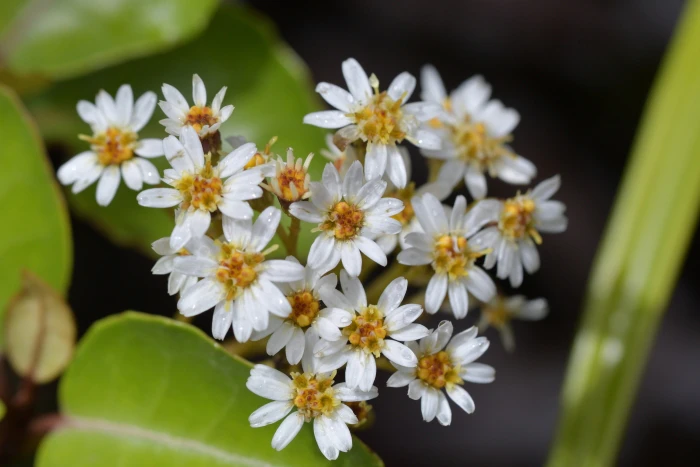Common Tree Daisy
(Olearia arborescens)
Common Tree Daisy (Olearia arborescens)
/
/

Christopher Stephens
CC BY-SA 4.0
Image By:
Christopher Stephens
Recorded By:
Copyright:
CC BY-SA 4.0
Copyright Notice:
Photo by: Christopher Stephens | License Type: CC BY-SA 4.0 | License URL: http://creativecommons.org/licenses/by-sa/4.0/ | Rights Holder: Christopher Stephens | Publisher: iNaturalist | Date Created: 2020-11-29T11:58:20-08:00 |





















































Estimated Native Range
Climate Requirements
| • Precipitation | 25" - 211" |
| • High Temp. | 47°F - 76°F |
| • Low Temp. | 11°F - 47°F |
Summary
Olearia arborescens, commonly known as Common Tree Daisy, is an evergreen shrub or small tree native to the coastal forests and shrublands of New Zealand, particularly the South Island. It typically grows to a height of 3-13 feet (1-4 meters) and a width of 2-10 feet (0.6-3 meters), featuring a rounded form with leathery, green leaves. The plant is notable for its profuse clusters of daisy-like, white flowers that bloom in spring, which are highly attractive to bees and other pollinators.
Common Tree Daisy is valued for its hardiness and the ornamental quality of its flowers, which add a splash of brightness to the garden in the spring. It is suitable for use in mixed borders, as a specimen plant, or for informal hedging. This species thrives in a range of soil types, provided they are well-drained, and it can tolerate coastal conditions, including salt spray. While it prefers full sun to part shade, it is also relatively drought-tolerant once established. Gardeners should be aware that Olearia arborescens can be prone to root rot if overwatered or planted in poorly drained soils.CC BY-SA 4.0
Common Tree Daisy is valued for its hardiness and the ornamental quality of its flowers, which add a splash of brightness to the garden in the spring. It is suitable for use in mixed borders, as a specimen plant, or for informal hedging. This species thrives in a range of soil types, provided they are well-drained, and it can tolerate coastal conditions, including salt spray. While it prefers full sun to part shade, it is also relatively drought-tolerant once established. Gardeners should be aware that Olearia arborescens can be prone to root rot if overwatered or planted in poorly drained soils.CC BY-SA 4.0
Plant Description
- Plant Type: Shrub, Tree
- Height: 6-13 feet
- Width: 6-10 feet
- Growth Rate: Moderate
- Flower Color: White
- Flowering Season: Spring
- Leaf Retention: Evergreen
Growth Requirements
- Sun: Full Sun, Part Shade
- Water: Medium
- Drainage: Fast, Medium
Common Uses
Bee Garden, Butterfly Garden, Low Maintenance, Street Planting
Natural Habitat
Coastal forests and shrublands of New Zealand, particularly the South Island
Other Names
Common Names: Forest Tree Daisy, Glossy Tree Daisy
Scientific Names: Olearia arborescens, Olearia nitida, Solidago arborescens, Eurybia alpina, Aster arborescens, Aster populifolius, Aster suborbiculatus, Dectis arborescens, Eurybia nitida
GBIF Accepted Name: Olearia arborescens (G.Forst.) Cockayne & Laing